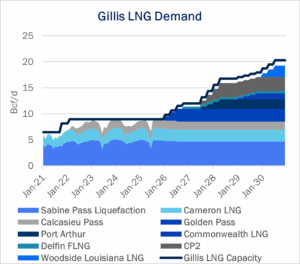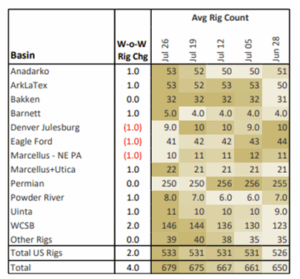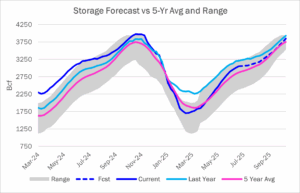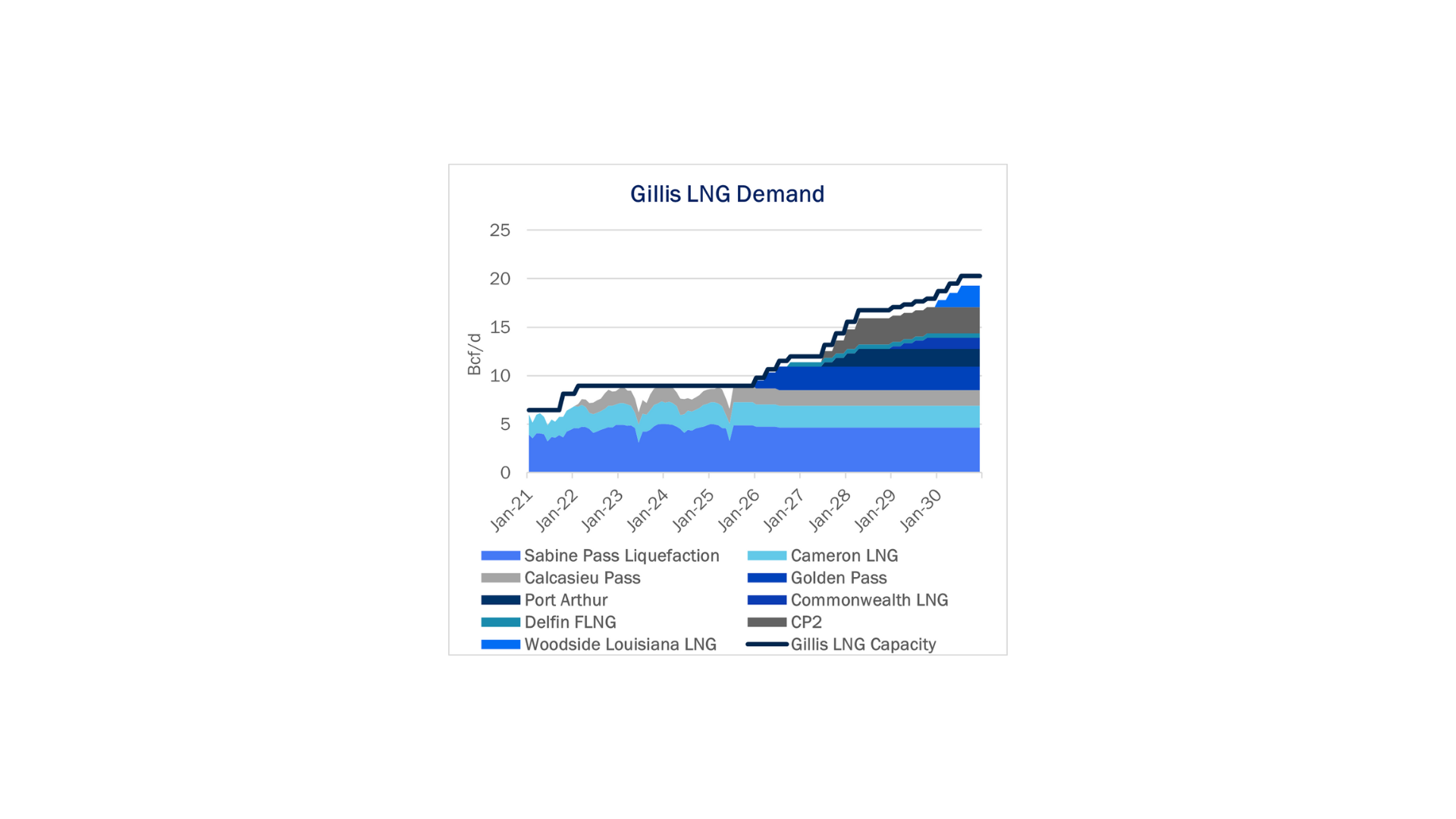Executive Summary:
Infrastructure: Venture Global made FID on CP2 LNG Phase 1, continuing momentum behind export growth.
Rigs: The US rig count increased by 2 for the July 26 week to 533 rigs.
Flows: US natural gas volumes averaged 70.9 Bcf/d in pipeline samples for the week ending August 3, up 0.5% W-o-W.
Storage: Traders expect the EIA to report a 10 Bcf injection for the week ending August 1.
Infrastructure:
Venture Global (VG) made a final investment decision (FID) for $15.1B on CP2 LNG Phase 1 and the associated CP Express Pipeline, which began construction early in July.
The company did not specify the size of Phase 1, but did note the facility will have a peak production capacity of 28 Mtpa (~4 Bcf/d) once fully built. East Daley Analytics models nameplate capacity of 20 Mtpa (~2.85 Bcf/d), and we have moved our in-service data forward to 3Q27 after this FID. By our count, CP2 currently has 1.5 Bcf/d of offtake volumes lined up under binding sales and purchase agreements (SPAs).
Despite the lack of clarity around project size, we can make some assumptions based on VG’s Plaquemines LNG, which shares the same 36 mini-train design. Plaquemines LNG FID’d in two phases of $13.2B and $7.8B, for a total of $21B. The jump from $13B to $15B is likely due to inflationary cost pressures rather than any differences between the project scope or construction schedules.

We also assume CP2 will follow Plaquemines LNG’s rapid ramp schedule. Plaquemines is already pulling over 2.6 Bcf/d, just seven months after the facility starting taking significant feedgas in January. The facility is on track to take as much as 4 Bcf/d by the end of the year, according to VG’s 1Q25 guidance.
Gillis LNG projects have seen significant momentum since the Trump administration came into office. The Department of Energy has expedited approval of non-free trade agreement export licenses, allowing both CP2 and Woodside Louisiana LNG to make quick FIDs. We expect Commonwealth LNG to follow suit as well, now that the project is nearly fully contracted under binding SPAs.
On the supply side, East Daley expects sufficient pipeline capacity will be available, at least through 2030. CP2 should be able to source adequate supply via Blackfin Pipeline and CP Express, which together form a supply line to Katy and access to cheap Permian gas.
Other projects like Woodside LNG have plenty of optionality out of the Gillis hub, as a slate of new Haynesville egress pipes come online over the next two years. Williams’ (WMB) LEG pipeline (1.8 Bcf/d) began service in late July, and Momentum’s NG3 (1.7 Bcf/d) won’t be far behind. WhiteWater Midstream also upgraded its Pelican Pipeline from 1.75 to 2.5 Bcf/d. Even DT Midstream’s (DTM) LEAP and Energy Transfer’s Gulf Run are not yet full, with plenty of potential expansion capacity available.
See East Daley’s Southeast Gulf Supply & Demand Report for a deeper review of the Gillis market.
Rigs:
The US rig count increased by 2 rigs for the July 26 week to 533. Several basins added a rig on the week, including the Anadarko, ArkLaTex, and Appalachia (-2) lost rigs. Several smaller basins gained rigs, including the Green River and Powder River, while other basins remained flat W-o-W.
On the midstream side, Targa Resources (TRGP) is down 2 rigs net with losses on its Permian and Eagle Ford systems. Western Midstream (WES) is up 2 rigs total with gains on its Permian systems.
See East Daley’s weekly Rig Activity Tracker for more information on rigs by basin and company.

Flows:
US natural gas volumes averaged 70.9 Bcf/d in pipeline samples for the week ending August 3, up 0.5% W-o-W from 70.5 Bcf/d the previous week.
The Permian sample increased 1.3% W-o-W to 6.4 Bcf/d. Gas basins were unchanged at a 44.1 Bcf/d average. The Haynesville sample declined 1.5% to 10.8 Bcf/d, while the Marcellus+Utica rose 0.4% to 32.3 Bcf/d.

Storage:
Traders and analysts expect the Energy Information Administration (EIA) to report a 10 Bcf injection for the week ending August 1. A 10 Bcf injection would decrease the surplus to the five-year average by 23 Bcf to 172 Bcf. The storage deficit to last year would drop 11 Bcf to 112 Bcf.
EIA reported a bearish 48 Bcf storage injection for the week ending July 25, well above market estimates for a 36 Bcf injection. With only moderate heat in forecasts for the rest of August, the September Henry Hub contract broke below $3 on Monday (August 4), settling at $2.93/MMBtu, and has struggled to hold the $3 level in trading this week.
Several factors are weighing on prices. Pipeline samples show production is increasing, hitting a high this year of 70.9 Bcf/d in East Daley’s latest survey for the August 5 week (see table above). Weather forecasts have moderated for the balance of August and show significant heat will largely be confined to the East Coast. Storage activity for the summer to date also has demonstrated a well-supplied market, making clear that demand for power generation is falling short of the record burn in 2024. A combination of higher gas prices, milder weather and increased renewables penetration have dampened demand. Finally, the market is approaching several challenging storage comparisons during the normal period of peak summer demand, including a 6 Bcf withdrawal for the week ending August 6, 2024, so the storage surplus is likely to expand in the near term.
We expect inventories at the end of October to total 3,849 Bcf – that means the average storage injection for the next 15 weeks would be around 52 Bcf/week. The five-year average injection over the same period is 55 Bcf/week.
See East Daley Analytics’ latest Macro Supply & Demand Report for more analysis on the storage outlook.

Calendar:

Subscribe to East Daley’s The Daley Note (TDN) for midstream insights delivered daily to your inbox. The Daley Note covers news, commodity prices, security prices, and EDA research likely to affect markets in the short term.



